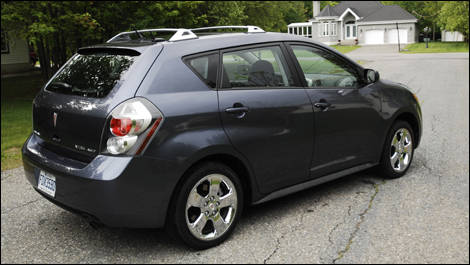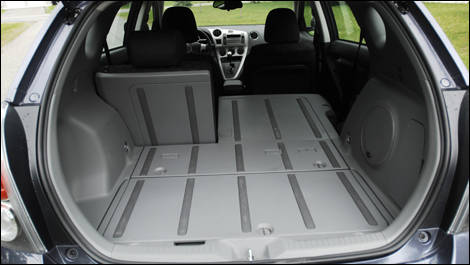Even though the Toyota Matrix, the Vibe's twin sister, is sold on a larger scale, the two companies have maintained their partnership in order to manufacture the second generation of their small hatchbacks.
The 2009 Pontiac Vibe sports a more futuristic look. The body is all angles, hardly a fluid line or curve to be seen, but this hard-cut style suits it very well. Despite its avant-garde tendencies, the car's design is contemporary and will age well. It won't make it into the history books, but the designers have deployed a solid effort.
The interior is a bit crowded, as was the case of the Pontiacs in the 1990s, and overflows with controls that could have been much simpler. It's obvious that the people at Pontiac wanted to go all out, but unfortunately they overdid it. Thankfully, the interior and exterior finishes are in good taste.
Our test vehicle didn't boast many convenient features, and the controls weren't absolutely ergonomic. In fact, they weren't very ergonomic at all: even if the sound system controls are part of the features, they weren't integrated into the steering wheel, which would have greatly improved the user-friendliness of the interior, and they weren't as pleasant to use as several of the others.
However, the audio system does pump out very good sound. The 7-speaker, 320-watt amplified Monsoon sound system is able and, above all, efficient.
The passenger compartment is well designed. Even if space is limited, the front and rear seats are easily accessible and comfortable, but not overly so. As for the cargo area, its modular design includes a subfloor that, upright, divides the space into compartments that allow you to organize your stuff. Again, and this is not very generous of me, you get the feeling that they could have done better.
The driving position, without being bad, is certainly not the Vibe's strong point: even though it offers appropriate visibility, it's not comfortable.
 |
| For 2009, the Pontiac Vibe sports a more futuristic look. |
The 2009 Pontiac Vibe sports a more futuristic look. The body is all angles, hardly a fluid line or curve to be seen, but this hard-cut style suits it very well. Despite its avant-garde tendencies, the car's design is contemporary and will age well. It won't make it into the history books, but the designers have deployed a solid effort.
The interior is a bit crowded, as was the case of the Pontiacs in the 1990s, and overflows with controls that could have been much simpler. It's obvious that the people at Pontiac wanted to go all out, but unfortunately they overdid it. Thankfully, the interior and exterior finishes are in good taste.
Our test vehicle didn't boast many convenient features, and the controls weren't absolutely ergonomic. In fact, they weren't very ergonomic at all: even if the sound system controls are part of the features, they weren't integrated into the steering wheel, which would have greatly improved the user-friendliness of the interior, and they weren't as pleasant to use as several of the others.
However, the audio system does pump out very good sound. The 7-speaker, 320-watt amplified Monsoon sound system is able and, above all, efficient.
The passenger compartment is well designed. Even if space is limited, the front and rear seats are easily accessible and comfortable, but not overly so. As for the cargo area, its modular design includes a subfloor that, upright, divides the space into compartments that allow you to organize your stuff. Again, and this is not very generous of me, you get the feeling that they could have done better.
The driving position, without being bad, is certainly not the Vibe's strong point: even though it offers appropriate visibility, it's not comfortable.
 |
| The modular design includes a subfloor that, upright, divides the space into compartments. |




